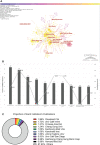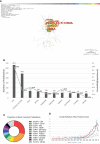Emerging trends and focus for the link between the gastrointestinal microbiome and kidney disease
- PMID: 36046740
- PMCID: PMC9420905
- DOI: 10.3389/fcimb.2022.946138
Emerging trends and focus for the link between the gastrointestinal microbiome and kidney disease
Abstract
The clinical value of the relationship between gastrointestinal microbiome imbalance and its corresponding interventions with kidney disease is emerging. This study describes the hotspots and evolution of gastrointestinal microbiome and kidney disease research over the past three decades by scientific collaboration networks and finally predicts future trends in the field through bibliometric analysis and visualization studies. CiteSpace was used to explore the original articles from January 1990 to August 2021 to visualize the knowledge network of journals, countries, institutions, authors, references, and keywords in this field. Publications were extracted from Web of Science Core Collection database using the terms "gastrointestinal microbiome" and "kidney disease" (and their synonyms in MeSH). A total of 2145 publications with 93880 references in 102 journals were included in the analyses. The number of studies combining gastrointestinal microbiomes with kidney diseases has increased significantly over the past two decades. The United States is the leading country in the number of documents, and the leading institution is the Cleveland Clinic. The most landmark articles in the field are on chronic renal failure, L-Carnitin, and cardiovascular disease. The pathogenesis of uremia toxin is an emerging trend in gastrointestinal microbiomes and kidney diseases. In addition, probiotic or synbiotic supplements have strong clinical value in adjusting abnormal intestinal symbiotic environments. This study demonstrates a growing understanding of the interaction between gut microbiota and kidney disease over time. Using microbial supplements to improve the living conditions of kidney disease patients is a promising and hot research focus. Based on publications extracted from the database, this study may provide clinicians and researchers with valuable information to identify potential collaborators and partner institutions and better predict their dynamic progression.
Keywords: bibliometric; gastrointestinal microbiome; kidney disease; probiotics; research focus.
Copyright © 2022 Tan, Chen, Wang, Tang and Qin.
Conflict of interest statement
The authors declare that the research was conducted in the absence of any commercial or financial relationships that could be construed as a potential conflict of interest.
Figures




Similar articles
-
Emerging trends and research foci in gastrointestinal microbiome.J Transl Med. 2019 Feb 28;17(1):67. doi: 10.1186/s12967-019-1810-x. J Transl Med. 2019. PMID: 30819194 Free PMC article.
-
Advances in gut microbiome in metabonomics perspective: based on bibliometrics methods and visualization analysis.Front Cell Infect Microbiol. 2023 May 30;13:1196967. doi: 10.3389/fcimb.2023.1196967. eCollection 2023. Front Cell Infect Microbiol. 2023. PMID: 37325519 Free PMC article.
-
Emerging trends and focus of human gastrointestinal microbiome research from 2010-2021: a visualized study.J Transl Med. 2021 Jul 31;19(1):327. doi: 10.1186/s12967-021-03009-8. J Transl Med. 2021. PMID: 34332587 Free PMC article. Review.
-
Gut microbiota and eye diseases: a bibliometric study and visualization analysis.Front Cell Infect Microbiol. 2023 Aug 9;13:1225859. doi: 10.3389/fcimb.2023.1225859. eCollection 2023. Front Cell Infect Microbiol. 2023. PMID: 37621873 Free PMC article.
-
Research focus and emerging trends of the gut microbiome and infant: a bibliometric analysis from 2004 to 2024.Front Microbiol. 2024 Nov 20;15:1459867. doi: 10.3389/fmicb.2024.1459867. eCollection 2024. Front Microbiol. 2024. PMID: 39633813 Free PMC article.
References
Publication types
MeSH terms
LinkOut - more resources
Full Text Sources
Medical
Miscellaneous

